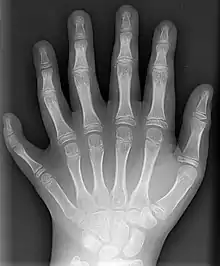polydactyly
English

A radiography of the left hand of a person with polydactyly
Etymology
From Ancient Greek πολυδάκτυλος (poludáktulos) + -y, from πολυ- (polu-, “many”) + δάκτυλος (dáktulos, “fingers, toes”), equivalent to poly- + dactyly or polydactyl + -y.
Pronunciation
- (Received Pronunciation) IPA(key): /ˌpɒl.ɪˈdak.tɪl.i/
Audio (Southern England) (file) - (General American) IPA(key): /ˌpɑl.iˈdæk.təl.i/
- Hyphenation: pol‧y‧dac‧tyl‧y
Noun
polydactyly (plural polydactylies)
- (teratology) A condition in which a person or animal has more than the usual number of digits (fingers or toes) on at least one of their hands or feet.
Hyponyms
Derived terms
Related terms
Translations
condition
|
This article is issued from Wiktionary. The text is licensed under Creative Commons - Attribution - Sharealike. Additional terms may apply for the media files.